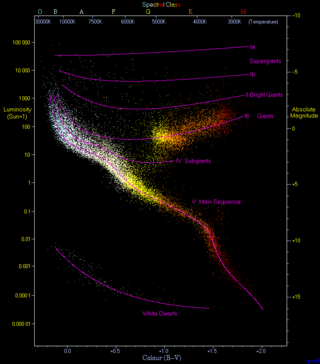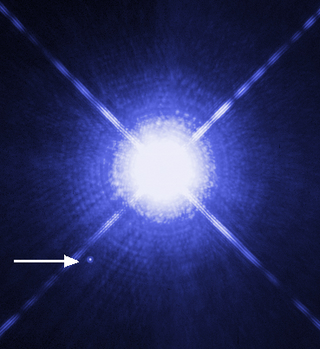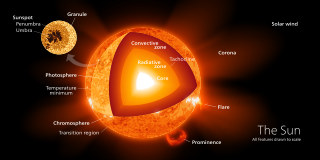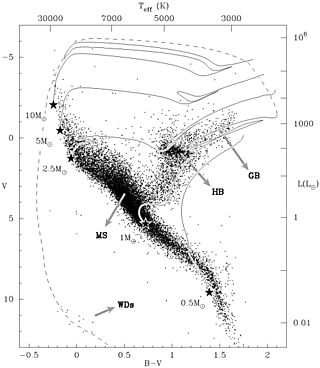Related Research Articles

In astronomy, the main sequence is a continuous and distinctive band of stars that appears on plots of stellar color versus brightness. These color-magnitude plots are known as Hertzsprung–Russell diagrams after their co-developers, Ejnar Hertzsprung and Henry Norris Russell. Stars on this band are known as main-sequence stars or dwarf stars. These are the most numerous true stars in the universe and include the Sun.

A star is an astronomical object comprising a luminous spheroid of plasma held together by self-gravity. The nearest star to Earth is the Sun. Many other stars are visible to the naked eye at night; their immense distances from Earth make them appear as fixed points of light. The most prominent stars have been categorised into constellations and asterisms, and many of the brightest stars have proper names. Astronomers have assembled star catalogues that identify the known stars and provide standardized stellar designations. The observable universe contains an estimated 1022 to 1024 stars. Only about 4,000 of these stars are visible to the naked eye—all within the Milky Way galaxy.

Stellar evolution is the process by which a star changes over the course of time. Depending on the mass of the star, its lifetime can range from a few million years for the most massive to trillions of years for the least massive, which is considerably longer than the current age of the universe. The table shows the lifetimes of stars as a function of their masses. All stars are formed from collapsing clouds of gas and dust, often called nebulae or molecular clouds. Over the course of millions of years, these protostars settle down into a state of equilibrium, becoming what is known as a main-sequence star.

A white dwarf is a stellar core remnant composed mostly of electron-degenerate matter. A white dwarf is very dense: its mass is comparable to the Sun's, while its volume is comparable to the Earth's. A white dwarf's low luminosity comes from the emission of residual thermal energy; no fusion takes place in a white dwarf. The nearest known white dwarf is Sirius B, at 8.6 light years, the smaller component of the Sirius binary star. There are currently thought to be eight white dwarfs among the hundred star systems nearest the Sun. The unusual faintness of white dwarfs was first recognized in 1910. The name white dwarf was coined by Willem Luyten in 1922.

Supergiants are among the most massive and most luminous stars. Supergiant stars occupy the top region of the Hertzsprung–Russell diagram with absolute visual magnitudes between about −3 and −8. The temperature range of supergiant stars spans from about 3,400 K to over 20,000 K.

Red supergiants (RSGs) are stars with a supergiant luminosity class of spectral type K or M. They are the largest stars in the universe in terms of volume, although they are not the most massive or luminous. Betelgeuse and Antares A are the brightest and best known red supergiants (RSGs), indeed the only first magnitude red supergiant stars.

Mira variables are a class of pulsating stars characterized by very red colours, pulsation periods longer than 100 days, and amplitudes greater than one magnitude in infrared and 2.5 magnitude at visual wavelengths. They are red giants in the very late stages of stellar evolution, on the asymptotic giant branch (AGB), that will expel their outer envelopes as planetary nebulae and become white dwarfs within a few million years.

A giant star is a star with substantially larger radius and luminosity than a main-sequence star of the same surface temperature. They lie above the main sequence on the Hertzsprung–Russell diagram and correspond to luminosity classes II and III. The terms giant and dwarf were coined for stars of quite different luminosity despite similar temperature or spectral type by Ejnar Hertzsprung about 1905.

The asymptotic giant branch (AGB) is a region of the Hertzsprung–Russell diagram populated by evolved cool luminous stars. This is a period of stellar evolution undertaken by all low- to intermediate-mass stars (about 0.5 to 8 solar masses) late in their lives.

A convection zone, convective zone or convective region of a star is a layer which is unstable due to convection. Energy is primarily or partially transported by convection in such a region. In a radiation zone, energy is transported by radiation and conduction.

The red-giant branch (RGB), sometimes called the first giant branch, is the portion of the giant branch before helium ignition occurs in the course of stellar evolution. It is a stage that follows the main sequence for low- to intermediate-mass stars. Red-giant-branch stars have an inert helium core surrounded by a shell of hydrogen fusing via the CNO cycle. They are K- and M-class stars much larger and more luminous than main-sequence stars of the same temperature.

A subgiant is a star that is brighter than a normal main-sequence star of the same spectral class, but not as bright as giant stars. The term subgiant is applied both to a particular spectral luminosity class and to a stage in the evolution of a star.

Sakurai's Object is a star in the constellation of Sagittarius. It is thought to have previously been a white dwarf that, as a result of a very late thermal pulse, swelled and became a red giant. It is located at the center of a planetary nebula and is believed to currently be in thermal instability and within its final shell helium flash phase.
A PG 1159 star, often also called a pre-degenerate, is a star with a hydrogen-deficient atmosphere that is in transition between being the central star of a planetary nebula and being a hot white dwarf. These stars are hot, with surface temperatures between 75,000 K and 200,000 K, and are characterized by atmospheres with little hydrogen and absorption lines for helium, carbon and oxygen. Their surface gravity is typically between 104 and 106 meters per second squared. Some PG 1159 stars are still fusing helium., § 2.1.1, 2.1.2, Table 2. The PG 1159 stars are named after their prototype, PG 1159-035. This star, found in the Palomar-Green survey of ultraviolet-excess stellar objects, was the first PG 1159 star discovered.
A technetium star, or more properly a Tc-rich star, is a star whose stellar spectrum contains absorption lines of the light radioactive metal technetium. The most stable isotope of technetium is 97Tc with a half-life of 4.21 million years, which is too short a time to allow the metal to be material from before the star's formation. Therefore, the detection in 1952 of technetium in stellar spectra provided unambiguous proof of nucleosynthesis in stars, one of the more extreme cases being R Geminorum.

A yellow supergiant (YSG) is a star, generally of spectral type F or G, having a supergiant luminosity class. They are stars that have evolved away from the main sequence, expanding and becoming more luminous.

A red giant is a luminous giant star of low or intermediate mass in a late phase of stellar evolution. The outer atmosphere is inflated and tenuous, making the radius large and the surface temperature around 5,000 K or lower. The appearance of the red giant is from yellow-white to reddish-orange, including the spectral types K and M, sometimes G, but also class S stars and most carbon stars.
A stellar core is the extremely hot, dense region at the center of a star. For an ordinary main sequence star, the core region is the volume where the temperature and pressure conditions allow for energy production through thermonuclear fusion of hydrogen into helium. This energy in turn counterbalances the mass of the star pressing inward; a process that self-maintains the conditions in thermal and hydrostatic equilibrium. The minimum temperature required for stellar hydrogen fusion exceeds 107 K (10 MK), while the density at the core of the Sun is over 100 g/cm3. The core is surrounded by the stellar envelope, which transports energy from the core to the stellar atmosphere where it is radiated away into space.

A super-AGB star is a star with a mass intermediate between those that end their lives as a white dwarf and those that end with a core collapse supernova, and properties intermediate between asymptotic giant branch (AGB) stars and red supergiants. They have initial masses of 7.5–9.25 M☉ in stellar-evolutionary models, but have exhausted their core hydrogen and helium, left the main sequence, and expanded to become large, cool, and luminous.
Ken'ichi Nomoto is a Japanese astrophysicist and astronomer, known for his research on stellar evolution, supernovae, and the origin of heavy elements.
References
- ↑ "Falk Herwig". Google Scholar . Retrieved May 4, 2014.
- ↑ Thomas Driebe; Falk Herwig (September 7, 1998). "The evolution of helium white dwarfs: I. The companion of the millisecond pulsar PSR J1012+5307" (Report). Cornell University Library. arXiv: astro-ph/9809079 . Bibcode:1998yCat..33390123D.
- ↑ Herwig, Falk (July 11, 2000). "The evolution of AGB stars with convective overshoot". University of Potsdam (Report). Cornell University Library. arXiv: astro-ph/0007139 .
- ↑ Falk Herwig; T Blöcker; N Langer; T Driebe (August 10, 1999). "On the formation of hydrogen-deficient post-AGB stars" (Report). Cornell University Library. arXiv: astro-ph/9908108 .